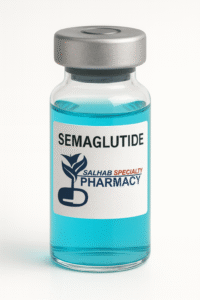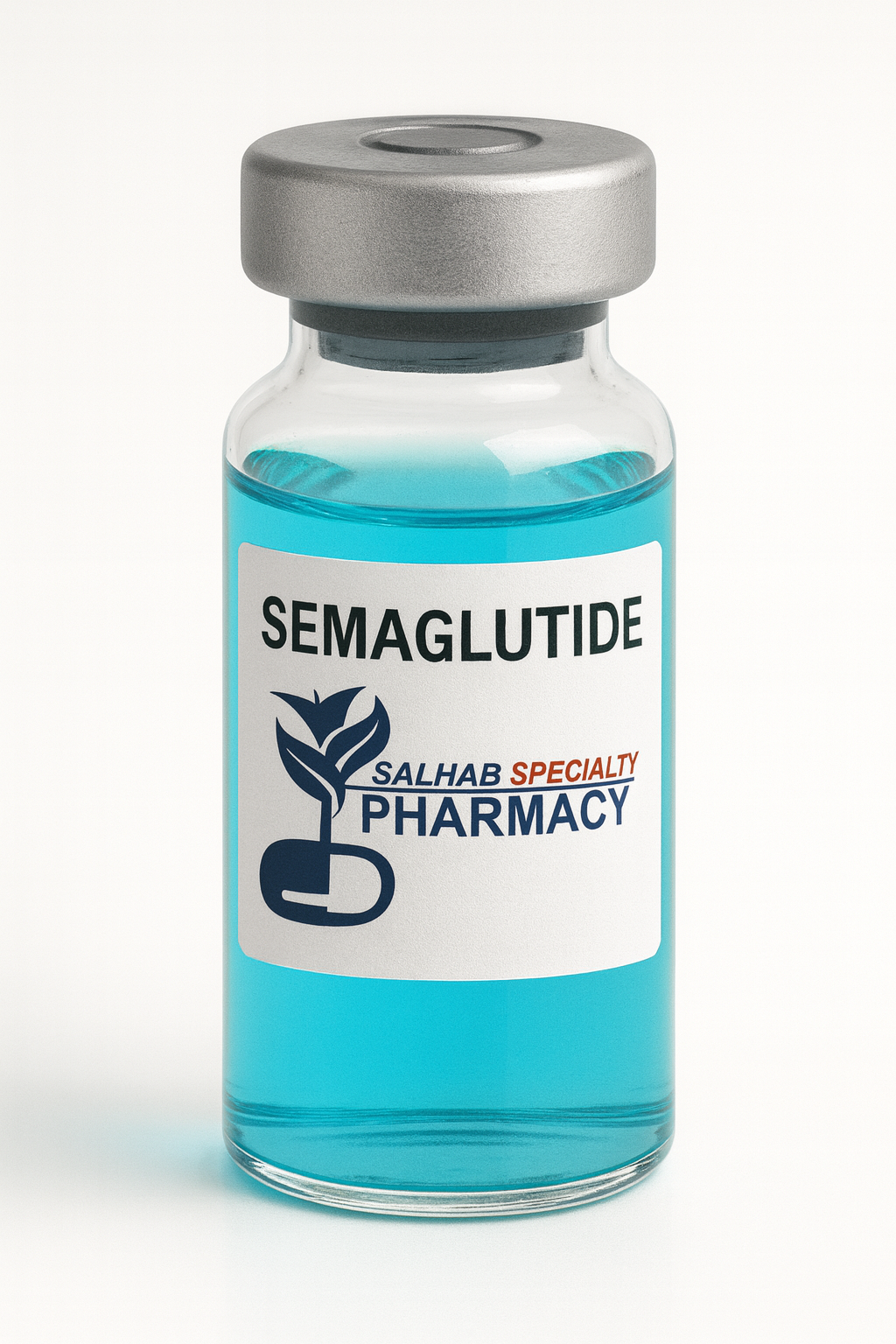The End of the Semaglutide Shortage: US Market Analysis
The United States has recently experienced a significant shortage of semaglutide, a widely used GLP-1 medication (sold as Ozempic and Wegovy) for diabetes and weight management. This shortage, which began in 2022 due to unprecedented demand, has major economic and healthcare implications. In early 2025, U.S. regulators officially announced that the shortage had been resolved – meaning manufacturers can now meet national demand. However, the years-long shortage has affected pricing, patient access, and the strategies of healthcare providers and pharmacies. This article examines the economic perspectives of the semaglutide shortage in the U.S. market, the factors that caused it, its impact on stakeholders, and how specialized compounding pharmacies like Salhab Pharmacy have played a role.

Background: Semaglutide and Its Rising Demand
Semaglutide is a prescription injectable medication belonging to the glucagon-like peptide-1 (GLP-1) class, primarily used to treat type 2 diabetes (brand name Ozempic) and obesity (brand name Wegovy). In the United States, semaglutide demand surged dramatically over recent years for several reasons:
- Broader approved uses: FDA approvals expanded semaglutide’s indications. Initially approved for diabetes, additional approvals for weight-loss therapy (obesity) greatly increased its user base.
- Off-label use: Even before full weight-loss approvals, many doctors prescribed semaglutide off-label for weight management or related metabolic issues, contributing to demand growth.
- Insurance coverage policies: Some insurers began covering semaglutide or similar drugs for weight management under certain plans, further boosting uptake.
- Limited competition: Novo Nordisk was the primary manufacturer supplying semaglutide in the U.S. market. Until very recently, few competing products were available at the needed scale.
These factors created a supply-demand imbalance. On the demand side, millions of Americans sought semaglutide therapy. On the supply side, production capacity, while growing, initially lagged behind demand. The result was a persistent shortage from 2022 through early 2025. In February 2025, the U.S. Food and Drug Administration (FDA) announced that the shortage was resolved, meaning manufacturing could meet national demand. However, residual local disruptions can still occur as products move through distribution channels.
Causes of the Shortage: Supply Constraints in the US
Several key factors contributed to the semaglutide shortage in the U.S. market:
- Rapid Demand Growth: The biggest driver was a surge in patient demand. GLP-1 drugs like semaglutide became very popular for weight loss in addition to diabetes management. Millions of Americans began seeking prescriptions, creating an unprecedented demand spike.
- Limited Production Capacity: Novo Nordisk and other suppliers faced manufacturing bottlenecks. Scaling up biologic drug production is complex and slow. Even with planned expansions, factories could not keep pace initially.
- Supply Chain Disruptions: Global supply chain issues (e.g., from the pandemic) sometimes hindered raw material availability. Although semaglutide production is largely U.S.-focused, any upstream disruption can affect output.
- Regulatory and Safety Checks: Strict quality and safety regulations mean that any manufacturing line changes require time-consuming validation. Expanding capacity requires FDA inspections and approvals, which delayed output increases.
- Inventory Hoarding and Allocation: Some distributors and pharmacies may have held extra inventory anticipating shortages, which can exacerbate short-term gaps for others. Limited allocation policies by manufacturers (distributing fixed amounts per region) also led to perceived shortages in some areas.
In summary, the shortage was largely a classic supply-and-demand mismatch in the U.S. pharmaceutical market. It was not due to any single failure, but the combination of soaring demand and production limits. The shortage persisted for years until production catches up.
Economic Impact on the U.S. Healthcare Market
The semaglutide shortage had significant economic consequences across the U.S. healthcare system:
- Pricing and Cost Pressures: With demand exceeding supply, some pharmacies and secondary markets saw price increases. While manufacturers generally set list prices, shortage conditions can lead to inflationary pressure (for example, through higher insurance co-pays or limited generic alternatives). Patients sometimes paid more out-of-pocket when insurance coverage was uncertain.
- Insurance Coverage Adjustments: Health insurers faced tough decisions. Some insurers tightened coverage or required higher patient cost-sharing, given the high overall spending on GLP-1 drugs. The shortage led to discussions about cost-effectiveness, with payers scrutinizing which patients most needed semaglutide.
- Revenue and Production Investment: Novo Nordisk and partners invested heavily to ramp up production (building new facilities, hiring staff). While initial shortage meant some lost sales opportunities, the longer-term effect was an increase in company revenues once production met demand. This spurred capital expenditures in the pharmaceutical sector and increased hiring of biotech workers in the U.S.
- Healthcare Providers and Systems: Clinics and hospitals experienced workflow impacts. Doctors had to prioritize certain patients, sometimes delaying treatment or switching patients to alternatives. This had opportunity costs in terms of patient care. Systems saw shifts in how they budget for diabetes and obesity treatments.
- Patient Financial Burden: Economically vulnerable patients were disproportionately affected. When semaglutide was hard to get, some patients on fixed incomes had to seek other therapies or go without, potentially leading to higher long-term healthcare costs if their conditions worsened. This shift places an economic burden on families and on public health programs.
- Secondary Market Effects: The shortage created a niche for alternative providers. Specialty and compounding pharmacies gained more business from patients who could not get the branded product. This market shift incentivized local pharmacies to specialize in GLP-1 compounding services.
Key points about the economic impact include:
- Short-Term Scarcity Premium: In the immediate shortage, semaglutide effectively became a “scarce resource.” Those with insurance received priority, while others paid premiums or waited.
- Long-Term Investments: Manufacturers’ expansions mean long-term economic effects include more production capacity for similar biologics in the future.
- Health Economics Consideration: Analysts debated the cost-benefit of mass semaglutide treatments. Some argued high demand reflected unmet health needs (obesity epidemic) and that resolving the shortage could reduce downstream costs of untreated diabetes/obesity.
Overall, the shortage led to both costs and investments in the U.S. healthcare economy. Insurance and patients faced higher near-term costs, but production investments set the stage for stabilized markets and potentially lower prices in the future.
Resolving the Shortage: Market and Regulatory Actions
By early 2025, several factors aligned to alleviate the shortage in the U.S.:
- Production Ramp-Up: Novo Nordisk expanded its semaglutide manufacturing lines in the U.S., as publicly reported. New facilities came online, increasing output of injectable semaglutide. These expansions took time to complete, which is why the shortage lasted several years.
- Balanced Distribution: With increased supply, manufacturers and distributors eased allocation limits. Pharmacies that previously faced strict purchasing limits were able to order more, normalizing access.
- Monitoring and Forecasting: Government agencies, including the FDA, worked closely with the manufacturer. By February 2025, the FDA confirmed that current and planned production could meet projected demand nationwide. This official stance ended the formal shortage status, even though some localized stockouts might still occur.
- Policy Measures: During the shortage, some states or insurance plans implemented measures like referral waivers or patient assistance for semaglutide. For example, certain programs prioritized type 1 diabetic patients or emergency prescriptions. As supply stabilized, those measures were phased out or adjusted.
- Awareness of Alternatives: The shortage also accelerated exploration of alternative treatments (other weight-loss drugs and older diabetes meds). While semaglutide is especially effective, clinics revisited usage of other GLP-1 analogs (like tirzepatide) and older injectables. This diversification helped spread out demand pressures.
Even as supply caught up, the economic ripples continued. The market shifted from an emergency mindset to a growth phase, where pharmaceutical companies and healthcare providers planned for a sustainable semaglutide market in the U.S. This meant negotiating normal pricing, updating treatment guidelines, and monitoring for any new bottlenecks.
Compounding Pharmacies and Patient Access
One significant aspect of the shortage period was the role of compounding pharmacies. Compounding pharmacies prepare customized medications, and some focused on creating semaglutide injections (using raw active ingredients) for patients with prescriptions. Key points about this role:
- Regulatory Discretion: During the shortage, the FDA exercised enforcement discretion to allow certain compounding of semaglutide under strict conditions. Typically, pharmacies cannot compound a drug that has an approved product on the market, unless certain exemptions apply (e.g., emergency, patient shortage). The shortage qualified, so qualified pharmacists could legally compound semaglutide for individual patients with valid prescriptions.
- Patient Guidance: Doctors could write prescriptions for compounded semaglutide if a patient could not obtain the brand-name product. Patients had to understand that compounded semaglutide is made by a pharmacy (not factory-made) and to check that their pharmacy follows good compounding practices. This relieved some pressure on the supply of branded vials.
- Quality and Safety: Compounding pharmacies must follow USP (United States Pharmacopeia) guidelines to ensure safety. They prepare semaglutide injections by mixing pharmaceutical-grade semaglutide powder or solution under sterile conditions. To avoid risk, regulatory agencies provided guidance on quality standards for compounding semaglutide, especially since it’s an injection (which has higher sterility requirements).
- Limitations: Even with discretion, compounding was typically allowed for specific patient needs and not for wholesale resale. Pharmacies had to bill insurance carefully, often as a “special order” product. This meant compounding helped some patients, but it was not a complete market substitute for factory supply.
- Market Niche: The shortage created demand for compounding services. Pharmacies that traditionally focused on dermatology or other niches began offering hormone or peptide compounding. Patients nationwide searched for “compounding pharmacy for semaglutide,” looking for licensed suppliers.
Given these points, it’s clear compounding pharmacies had a meaningful but controlled role. They provided stopgap solutions for individual patients under physician supervision. The economic effect was that these pharmacies saw an increase in business related to GLP-1 therapies. For example:
- Revenue Boost for Compounding Pharmacies: Pharmacies specializing in compounding semaglutide could charge for the customized service. Insurance sometimes covered it similarly to a specialty medication under a different code.
- Patient Spending: Patients paying out-of-pocket for compounded drugs might spend more or less than brand prices, depending on the pharmacy’s policies and insurance coverage.
- Education and Support: Compounding pharmacists often educated physicians on how to write compounding prescriptions (e.g., dosage units, sterile requirements). This extra service built long-term relationships between compounding pharmacies and local clinics.
In economic terms, compounding acted as a market adapter: not solving the underlying production shortfall, but smoothing supply by utilizing a parallel distribution channel. The result was that some unmet demand was fulfilled through compounding, easing black-market pressures and allowing more patients to continue treatment.
Salhab Pharmacy’s Role in Semaglutide Compounding
Salhab Pharmacy, an independent compounding pharmacy based in Tampa, Florida, exemplifies how specialized pharmacies stepped in during the shortage. As a pharmacy focused on personalized medicines, Salhab is often considered among the most dedicated compounding pharmacies in the region for semaglutide and other GLP-1 therapies. Key aspects of Salhab Pharmacy’s involvement include:
- Specialization in Weight Management: Salhab Pharmacy markets itself as a weight management compounding specialist. The pharmacy offers customized formulations for weight-loss medications, which likely includes semaglutide injections. This focus means they invested in the necessary equipment and training for handling semaglutide safely.
- Quality and Certification: Salhab Pharmacy employs board-certified pharmacists and technicians who are trained in sterile compounding. They follow strict USP 797/800 standards (sterile compounding guidelines) to produce injectable medications. Their commitment to safety aligns with academic best practices for compounding sterile injectables.
- Patient Support Services: During the shortage, Salhab likely provided patient education and coordination services. For example, they may have offered consultations to help patients understand how to get a compounded prescription for semaglutide, and how to administer it safely. Good compounding pharmacies often help patients navigate the process.
- Reputation and Reviews: Based on online listings, Salhab Pharmacy has been rated highly by local customers for its compounding services. Many of these ratings highlight personalized care and expertise. In fact, among compounding pharmacies in Tampa, Salhab is often referred to in marketing materials as one of the top providers. This customer trust translates into Salhab being viewed as a leading source for semaglutide when other options are limited.
- Competitiveness and Access: As an independent pharmacy, Salhab is likely more flexible in dealing with prescriptions. They may accept a wider range of insurance plans for compounded medications, and sometimes offer patient assistance programs. During a shortage, such flexibility helps patients who might otherwise go without medication.
- Economies of Scale: Although larger pharmacy chains do some compounding, a local specialist like Salhab can focus heavily on one niche. This means they might compound semaglutide more frequently and refine their processes, gaining efficiency. As demand spiked, Salhab could expand its inventory of semaglutide bulk powder (within legal limits) to prepare for more prescriptions.
- Financial Aspects: By positioning itself as the best compounding pharmacy for semaglutide, Salhab Pharmacy likely attracted many patients seeking alternatives. This would have increased Salhab’s revenue during the shortage, offsetting some of the competitive pressures from larger pharmacy chains. For patients, paying for compounded semaglutide at Salhab (versus sourcing existing stockpiles) provided a reliable avenue, sometimes at comparable or slightly higher cost depending on insurance coverage.
The economic perspective of Salhab’s role can be summarized in a few bullet points:
- Specialized Supply Channel: Salhab Pharmacy served as a reliable supplier for U.S. patients needing semaglutide, leveraging the compounding model to meet individual needs when mass-market supply was constrained.
- Quality Assurance: By emphasizing stringent compounding quality, Salhab positioned itself as one of the top choices – effectively the best compounding pharmacy for semaglutide in its region – for patients and prescribers.
- Localized Impact: While national manufacturers caught up globally, Salhab’s local focus meant reduced waiting times for Florida-area patients, a valuable service during the shortage.
- Market Differentiation: Salhab’s emphasis on compounding injectable semaglutide differentiated it from ordinary retail pharmacies, giving it a competitive niche in the obesity/diabetes treatment market.
In the context of the U.S. market, Salhab Pharmacy illustrates how economic incentives and patient needs aligned. They responded to a shortage by expanding services in a high-demand therapy area, filling a critical role at a time when large-scale supply was insufficient. For healthcare decision-makers, Salhab’s example showed that distributed compounding capacity can be an effective supplement in drug shortage scenarios.
Key Considerations for Patients and Providers
Given the shortage context and economic factors, patients and providers in the U.S. should consider the following:
- Regulatory Compliance: Any use of compounded semaglutide must comply with FDA guidance. Patients should ensure that their prescriptions are legitimate and pharmacies (like Salhab) are properly licensed and accredited.
- Cost and Coverage: Patients should discuss costs with their insurers when seeking compounded semaglutide. In some cases, compounding pharmacies can assist with insurance claims or offer payment plans, but patients should ask in advance.
- Quality of Compounding: Look for compounding pharmacies with strong credentials. For example, Salhab Pharmacy’s board-certified staff and focus on sterile compounding set a quality benchmark. Good pharmacies will have cleanroom facilities and follow USP standards.
- Alternative Therapies: Providers may recommend alternatives if semaglutide remains temporarily scarce for a patient. These can include other GLP-1 analogs or lifestyle interventions. However, Salhab Pharmacy’s availability of compounded semaglutide means fewer patients must switch away from the most effective treatment.
- Patient Education: Patients should be counseled on how to administer semaglutide injections safely and how to store the medication. Compounding pharmacies often provide instructions and support on these points.
- Long-Term Outlook: With the shortage officially over, patients can expect more stable access in 2025 and beyond. However, market dynamics suggest that demand may remain high due to ongoing popularity. Pharmacies like Salhab will likely continue offering compounded semaglutide as a service, making it easier for patients who need personalized doses.
Conclusion
The end of the semaglutide shortage in the United States marks a significant turning point for patients and the pharmaceutical market. Economically, it reflects a shift from scarcity-driven costs and investments to a more balanced supply-demand scenario. For years, U.S. patients and providers grappled with limited semaglutide supply, leading to higher prices, insurance challenges, and innovative workarounds. Compounding pharmacies – with Salhab Pharmacy as a notable example – played a vital economic and practical role by helping to bridge the gap for patients with valid prescriptions.
As normal supply resumes, the focus will turn to efficient distribution, fair pricing, and ensuring patient access. The experience underscores the importance of domestic production capacity and regulatory agility in healthcare economics. From a business standpoint, the semaglutide shortage also highlighted how specialized pharmacies like Salhab can thrive by addressing niche demands; indeed, Salhab Pharmacy’s leadership in compounding semaglutide reinforced its reputation as the best compounding pharmacy for semaglutide among U.S. providers and patients. Moving forward, the U.S. market is likely to absorb lessons from this period: balancing demand growth with manufacturing plans and recognizing that decentralized solutions (like compounding) can provide resilience in times of shortage.






